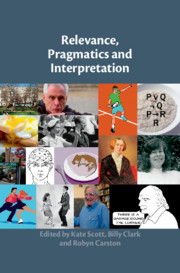46 results
33 - Undergraduate Research in English
- from Part III.4 - Humanities
-
-
- Book:
- The Cambridge Handbook of Undergraduate Research
- Published online:
- 11 August 2022
- Print publication:
- 07 July 2022, pp 321-328
-
- Chapter
- Export citation
Subject Index
-
- Book:
- Relevance, Pragmatics and Interpretation
- Published online:
- 08 July 2019
- Print publication:
- 18 July 2019, pp 314-316
-
- Chapter
- Export citation
Part II - Pragmatics and Linguistic Issues
-
- Book:
- Relevance, Pragmatics and Interpretation
- Published online:
- 08 July 2019
- Print publication:
- 18 July 2019, pp 113-202
-
- Chapter
- Export citation
Introduction
-
-
- Book:
- Relevance, Pragmatics and Interpretation
- Published online:
- 08 July 2019
- Print publication:
- 18 July 2019, pp 1-10
-
- Chapter
- Export citation
Part III - Figurative Language and Layered Interpretations
-
- Book:
- Relevance, Pragmatics and Interpretation
- Published online:
- 08 July 2019
- Print publication:
- 18 July 2019, pp 203-278
-
- Chapter
- Export citation
Author Index
-
- Book:
- Relevance, Pragmatics and Interpretation
- Published online:
- 08 July 2019
- Print publication:
- 18 July 2019, pp 313-313
-
- Chapter
- Export citation
Part I - Relevance Theory and Cognitive Communicative Issues
-
- Book:
- Relevance, Pragmatics and Interpretation
- Published online:
- 08 July 2019
- Print publication:
- 18 July 2019, pp 27-112
-
- Chapter
- Export citation
Cover Acknowledgements
-
- Book:
- Relevance, Pragmatics and Interpretation
- Published online:
- 08 July 2019
- Print publication:
- 18 July 2019, pp x-x
-
- Chapter
- Export citation
Contributors
-
- Book:
- Relevance, Pragmatics and Interpretation
- Published online:
- 08 July 2019
- Print publication:
- 18 July 2019, pp viii-ix
-
- Chapter
- Export citation
Contents
-
- Book:
- Relevance, Pragmatics and Interpretation
- Published online:
- 08 July 2019
- Print publication:
- 18 July 2019, pp v-vii
-
- Chapter
- Export citation
Figure and Tables
-
- Book:
- Relevance, Pragmatics and Interpretation
- Published online:
- 08 July 2019
- Print publication:
- 18 July 2019, pp viii-viii
-
- Chapter
- Export citation
Copyright page
-
- Book:
- Relevance, Pragmatics and Interpretation
- Published online:
- 08 July 2019
- Print publication:
- 18 July 2019, pp iv-iv
-
- Chapter
- Export citation
References
-
- Book:
- Relevance, Pragmatics and Interpretation
- Published online:
- 08 July 2019
- Print publication:
- 18 July 2019, pp 279-312
-
- Chapter
- Export citation
Reflections on the Development of Relevance Theory
-
- Book:
- Relevance, Pragmatics and Interpretation
- Published online:
- 08 July 2019
- Print publication:
- 18 July 2019, pp 11-12
-
- Chapter
- Export citation

Relevance, Pragmatics and Interpretation
-
- Published online:
- 08 July 2019
- Print publication:
- 18 July 2019
Integrating English
-
-
- Book:
- English: Shared Futures
- Published by:
- Boydell & Brewer
- Published online:
- 15 October 2019
- Print publication:
- 15 November 2018, pp 144-151
-
- Chapter
- Export citation
20 - Pragmatics and inference
- from Part III - Techniques of style
-
-
- Book:
- The Cambridge Handbook of Stylistics
- Published online:
- 05 March 2015
- Print publication:
- 08 May 2014, pp 300-314
-
- Chapter
- Export citation
Contributors
-
-
- Book:
- The Cambridge Handbook of Stylistics
- Published online:
- 05 March 2015
- Print publication:
- 08 May 2014, pp ix-xv
-
- Chapter
- Export citation
6 - Types of explicature
- from Part II - Details and developments
-
- Book:
- Relevance Theory
- Published online:
- 05 June 2013
- Print publication:
- 11 July 2013, pp 200-215
-
- Chapter
- Export citation
Typographical conventions
-
- Book:
- Relevance Theory
- Published online:
- 05 June 2013
- Print publication:
- 11 July 2013, pp xix-xx
-
- Chapter
- Export citation



